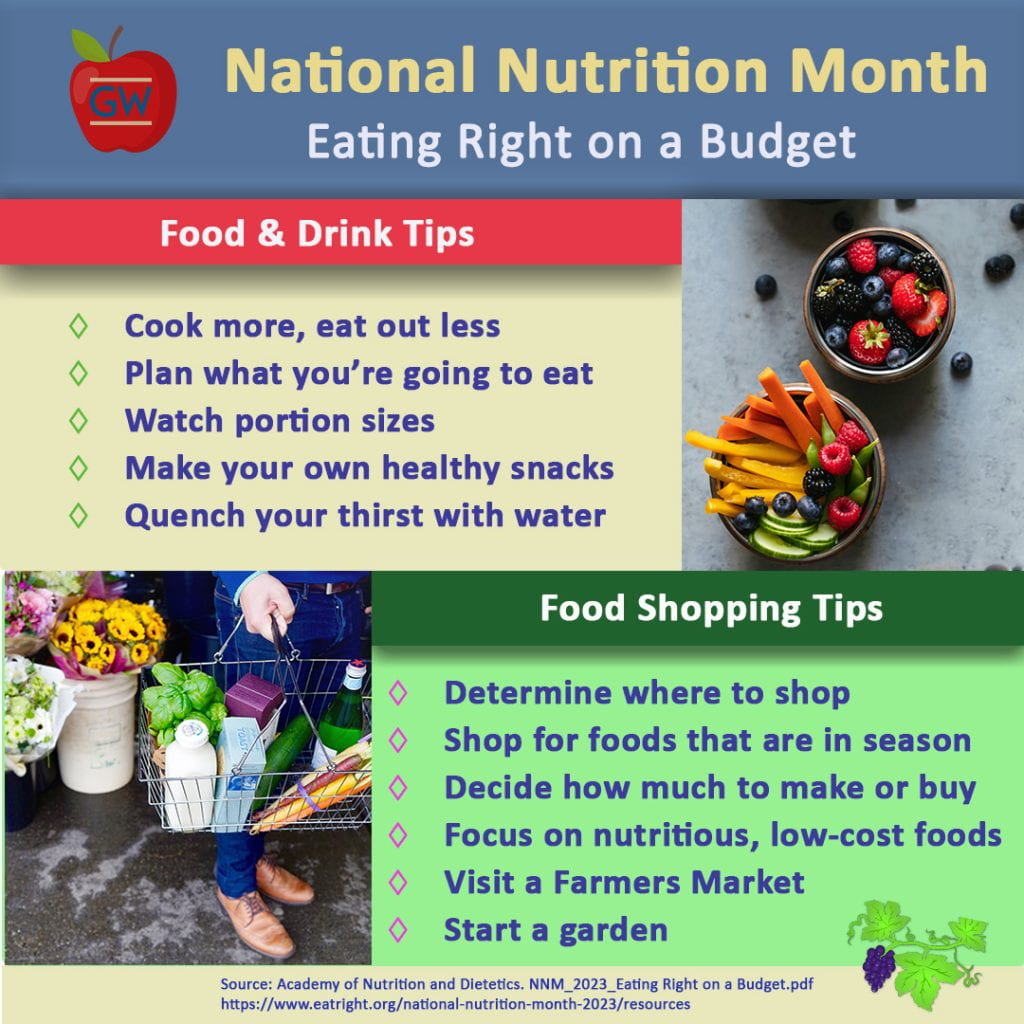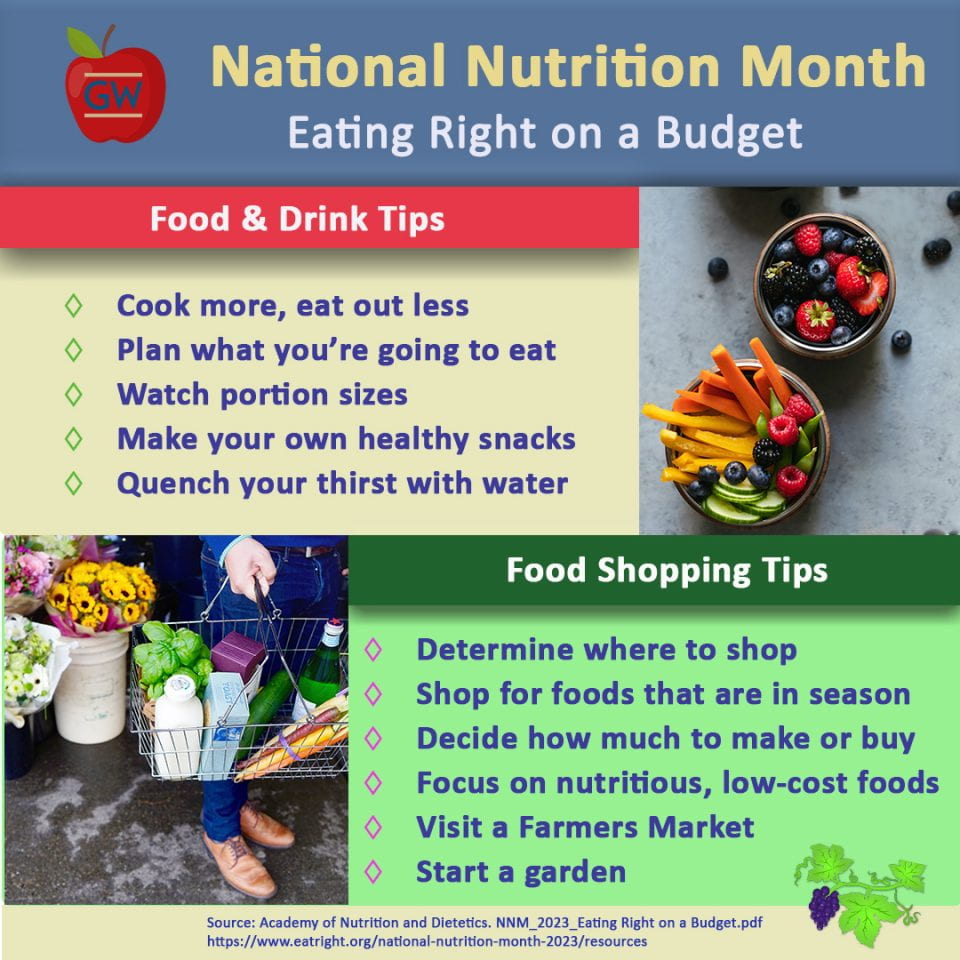
This March marks the 50th anniversary of National Nutrition Month! You can celebrate by following simple steps that will help you get the most nutritional value out of your food and save some money.
Cook More, Eat Out Less
Deciding to grab dinner out after a busy day can be appealing, but it’s often cheaper and healthier to prepare your meals at home than it is to eat out. Cooking at home doesn’t have to be time-consuming or difficult - there are plenty of quick, easy, and healthy recipes to try. Do some internet searching or check out the cookbooks in Himmelfarb’s Healthy Living Collection to find healthy recipes that will get you to spend more time in your kitchen and less time eating out. Even social media accounts can be a source of recipes and inspiration in the kitchen.
You don’t have to have chef-level skills to get in the kitchen and produce some healthy meals! Whether you’re not confident in your cooking skills or simply want to learn something new, taking a cooking class can be a fun way to spice things up in the kitchen. GW’s Culinary Medicine Program offers free, hands-on cooking classes open to the public. Virtual, hybrid, and in-person classes are available throughout the year. The next 6-week course is an in-person session (held at the Seva Teaching Kitchen) that starts on April 19, 2023! Complete the interest form to learn more.
Meal Planning & Preparation
Making a plan for your meals and snacks before you go grocery shopping is a successful strategy for saving time and money. Review the recipes you want to make during the week and create a list of ingredients you’re missing. Shopping with a list increases your chances of remembering what you need, and decreases impulse purchases. When planning your meals, consider doubling the recipe. Leftovers can be reheated and eaten later in the week, or frozen for an easy ready-made meal next month. Whether you freeze leftovers or eat them the next day, you’ve just saved time by preparing multiple meals. As a bonus, buying ingredients in bulk often saves money too.
Watch Portion Sizes
Consuming smaller portions can make a big impact on your calorie intake and how much you spend on food. Simple changes like using smaller plates, bowls, and glasses can help you keep those portion sizes reasonable. Filling half of your plate with fruits and veggies, and the other half with grains and proteins can be an easy way to ensure you’re getting a balanced meal while controlling portion sizes.
Make Healthy Snacks
Most pre-packaged snacks, even the healthy options, aren’t cheap. Save money by making your snacks. Buying bulk tubs of yogurt or cottage cheese and dividing them into smaller containers for an easy grab-and-go option is an easy way to save money and have easy snack options. Homemade trail mix is another easy option - combine your favorite ingredients (nuts, dried fruit, pretzels, cereal), mix, and store in smaller grab-and-go containers for easy snacking. In-season fresh fruits are also a great nutritious option!
Quency Thirst with Water
Swapping out water in place of soda, energy drinks or sports drinks can be a great way to stay hydrated while saving money and reducing added calories! You’ll get to skip the added sugars for an extra health bonus! Tap water (filter it in your preferred filter pitcher if you choose) in a reusable water bottle is a great way to stay hydrated on the go.
Food Shopping Tips
Knowing where to shop can save you money. Taking advantage of store coupons (often available directly on the store's rewards websites) can save you money. Take the time to compare prices between brands and look at unit prices to determine if the cheapest price is the best deal. In-season foods are generally cheaper than out-of-season foods, but frozen produce can be a great option for out-of-season items. Focus on nutritious foods that are also low-cost to get the highest value from your grocery budget.
Additional Resources
Interested in learning more about nutrition? Himmelfarb Library has a variety of resources available! Explore our Nutrition Research Guide to find information on nutrition reports and guidelines, links to professional associations, data and statistics resources, and websites. You’ll also find a variety of print and electronic books, nutrition journals, and databases.
References:
Academy of Nutrition and Dietetics. (2023). Eating right on a budget. https://www.eatright.org/-/media/files/campaigns/eatright/nnm-2023/english/tip-sheets-english/nnm_2023_eating-right-on-a-budget.pdf



